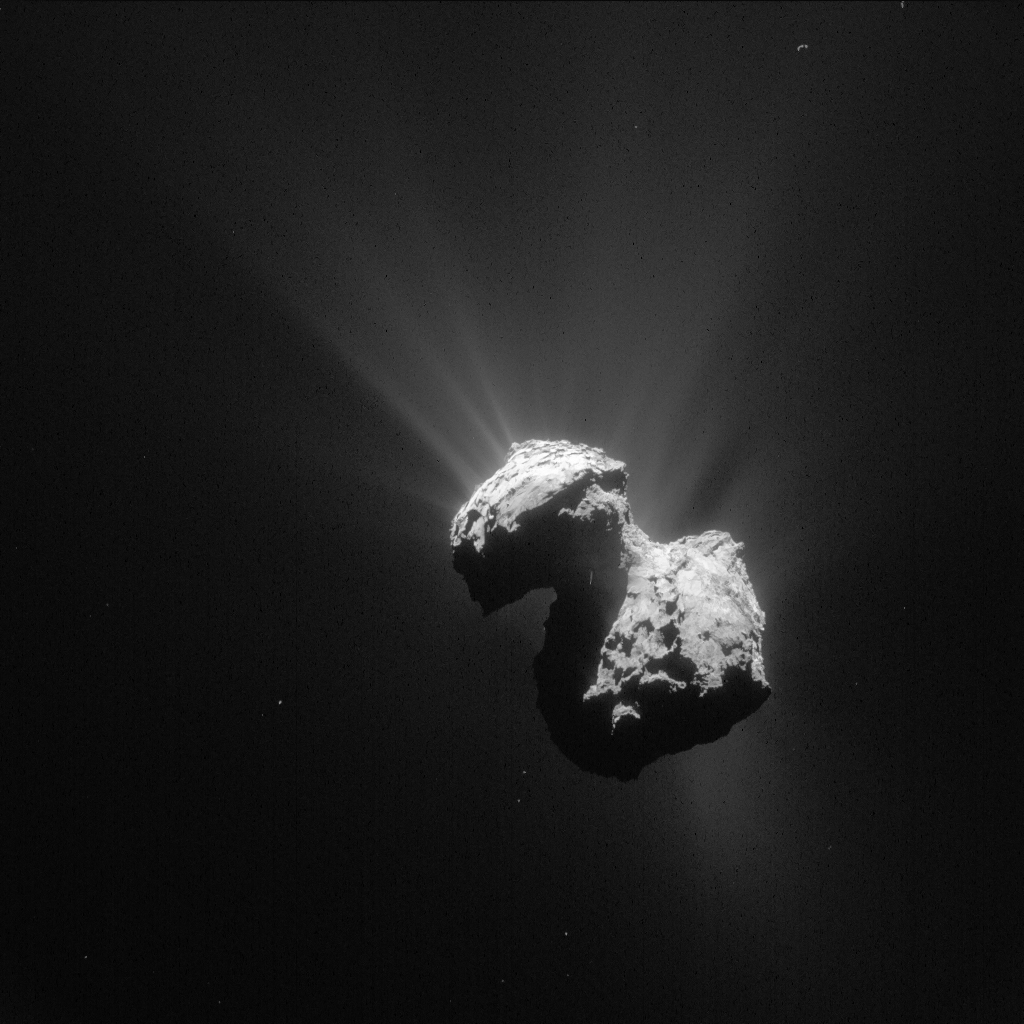4 Earth Origin in the Nutshell (from Big Bang to Proterozoic)
KEY CONCEPTS
- Historical views on Universe and Earth Position.
- Explain the Big Bang and the origin of the elements.
- Explain the solar system’s and Earth origin.
Earth history is a wide ranging topic that entire courses and scientific careers are based on. Throughout the long history of Earth, change has been the norm. If travelling back in time, many life forms and terrains would be unfamiliar to the untrained eye. The main topics that are studied in Earth History are the past landscapes (paleogeography), organisms (paleontology), and environments (paleoecology and paleoclimatology). This chapter will highlight the basic ideas that are part of the study of the Earth, including the start of the Universe and early Earth evolution.
 Geologic time on Earth, represented circularly, to show the individual time divisions and important events. Ga=billion years ago, Ma=million years ago. For example, 2300 Ma is 2,300,000,000 years.
Geologic time on Earth, represented circularly, to show the individual time divisions and important events. Ga=billion years ago, Ma=million years ago. For example, 2300 Ma is 2,300,000,000 years.
Historic Views on Universe and Earth Position
Throughout the human history two main theories prevailed on Universe structure: heliocentric (helio – sun; centric – center) and geocentoric (geo – earth; centric – center). Geocentric hypothesis was established in 2nd century AD by Greek philosopher Ptolemy who considered Earth as a center of the universe on the basis of studying stars and considering them on the equal distance from the Earth (see more on Wikipedia article: https://en.wikipedia.org/wiki/Geocentric_model#Ptolemaic_system). Also, at that time people saw Sun revolving at least once around the Earth and this also contributed to support of geocentric model. Heliocentric hypothesis was mathematically proved by Nicolaus Copernicus in 16th century and then used by Johannes Kepler‘s in his laws of planetary motions. Kepler (see: https://en.wikipedia.org/wiki/Johannes_Kepler) introduced elliptical orbits of planets around the sun. This contribution became one of the most fundamental in astronomy.
Origin of the Universe
In the beginning, time and space were initiated in the Big Bang and the universe formed from an infinitely dense and hot core of material, condensed in a single point. The Universe appears to have an infinite reach and an infinite number of stars in galaxies reaching far and wide, of which our galaxy and solar system occupy a seemingly obscure and insignificant section of the entirety. The details of the origin of the Universe, and especially any details of events before the moment of its creation, are subject to great debate and mystery, but are detailed in The Big Bang Theory. Though the ideas behind the Big Bang Theory feel almost mystical, they are helped by complex ideas in Einstein’s theory of general relativity . The evidence that has supported this theory, however, is grounded in straightforward empirical observations.
1. Big Bang Theory
The Big Bang theory is the idea that after the beginning of the universe (the ‘bang’ in the title), all matter and space (called space-time by Einstein) expanded explosively outward from a single, dense matter, and has continued to expand in the 13.8 billion years since.
The history of the name is interesting: In 1940s Fred Hoyle (English physicist) proposed an alternative theory called “Steady-State”. That theory asserted that universe always existed. Expansion happens because the matter is being born between galaxies, so they move apart. In the spring of 1949 the BBC asked Hoyle to write and present series of talks on the nature of universe. To describe his opponent theory Hoyle used expression “Big Bang”. It was meant as term for derision, but name stuck.
Recent observations have suggested that the universe is continuing to expand, only at a more and more rapid rate . Shortly after the Big Bang, atoms were also created, and most of these were hydrogen. Hydrogen still makes up about 74% of all matter observed.

The expansion of the universe was supported by astronomical observations and measurements, specifically measurements of stars spectrums and their analysis based on Doppler Effect. The Doppler Effect is the same wavelength process that changes the pitch of the sound of a car or ambulance from high to low as it approaches then passes. When an object emits waves, such as sound waves, but also moves toward an observer, wavelengths get compressed (higher pitch as with sound). When an object moves away from an observer, the wavelengths become longer (lower pitch as with sound). This effect is used on the light emitted from stars and galaxies to determine their speed and direction of travel .

No one told Bob how hard it would be to find his Uber without knowledge of the Doppler’s Effect
Source: https://twitter.com/NESTA_US/status/1118155865133965314
Scientists, including Slipher and Hubble , examined galaxies both near and far, and found that almost all galaxies outside of our galaxy are moving away from each other and us. Because the wavelengths of receding objects are extended, this shifts visible light toward the red end of the spectrum and is called redshift.
Below is a set of light spectrums obtained in the lab, from distant galaxy, etc.
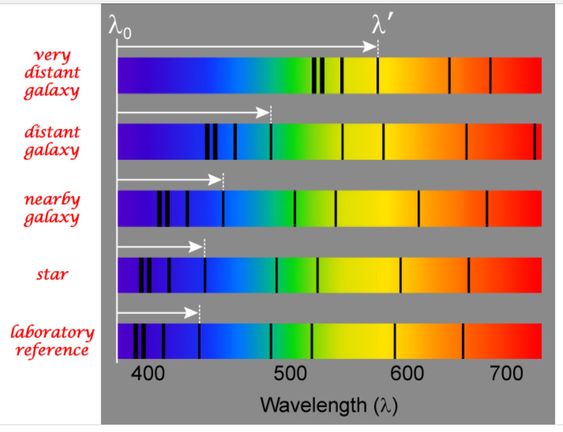
You can see how spectrum lines move to the right toward red spectrum. Line spectrums are wavelengths related to chemical elements, for example 393 and 397 nm are from calcium, 410, 434, 486 and 656 nm are from hydrogen, 518 nm is from magnesium and 589 nm from sodium.
Becuase it is a light spectrum, any percent of change in element’s wavelength is related to the speed. For example, 1% of shift to the right means that the object ismoving away with a speed of 3,000 km/sec. Light speed in km is approx 300,000 km/sec.
Not only that, Hubble noticed the further away galaxies are, the larger the redshift, and thus, the faster they are traveling away from us. The only way to reconcile this information is to deduce the universe itself as expanding. This is the origin of the Big Bang Theory, and the reverse of this expansion gives scientists the 13.8 billion year age of the universe.
COSMIC MICROWAVE BACKGROUND RADIATION
Another strong indication of the Big Bang event is cosmic microwave background radiation. This was accidentally discovered by Arno Penzias and Robert Wilson when they were trying to eliminate background noise from a communication satellite. They discovered a very faint energy, or heat, that is omnipresent across the universe. This is energy left behind from the Big Bang itself, similar to an echo.
Stellar Evolution
It is thought the Big Bang created mostly hydrogen, and smaller amounts of element Helium, Lithium and Beryllium. Another process must be responsible for the nearly 90 other natural elements on Earth. The current model of stellar evolution explains the origins of the other heavier elements.
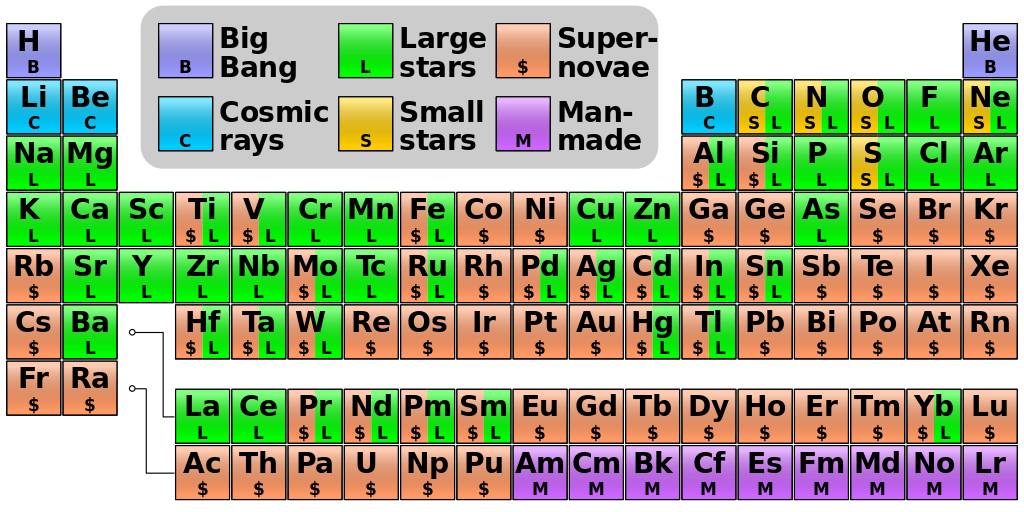 Origin of the elements on the periodic table, showing the important role the star life cycle plays.
Origin of the elements on the periodic table, showing the important role the star life cycle plays.
BIRTH OF A STAR
Stars start their lives as elements floating in cold, spinning clouds of gas and dust known as nebulas. Gravitational attraction or perhaps a nearby stellar explosion causes the elements to start to condense and spin into disk shape. In the center of this disk shape a new star is born. Under the force of gravity, the spinning whirlpool of material concentrates in the middle, making the gravitational forces collect even more mass. Eventually, the immense concentration of mass reaches a critical point where the heat and pressure are so high that fusion initiates. Fusion is a nuclear reaction in which two or more nuclei (center of an atom) are forced together and combine. This gives off a tremendous amount of energy. This energy is often observed as light and solar radiation.
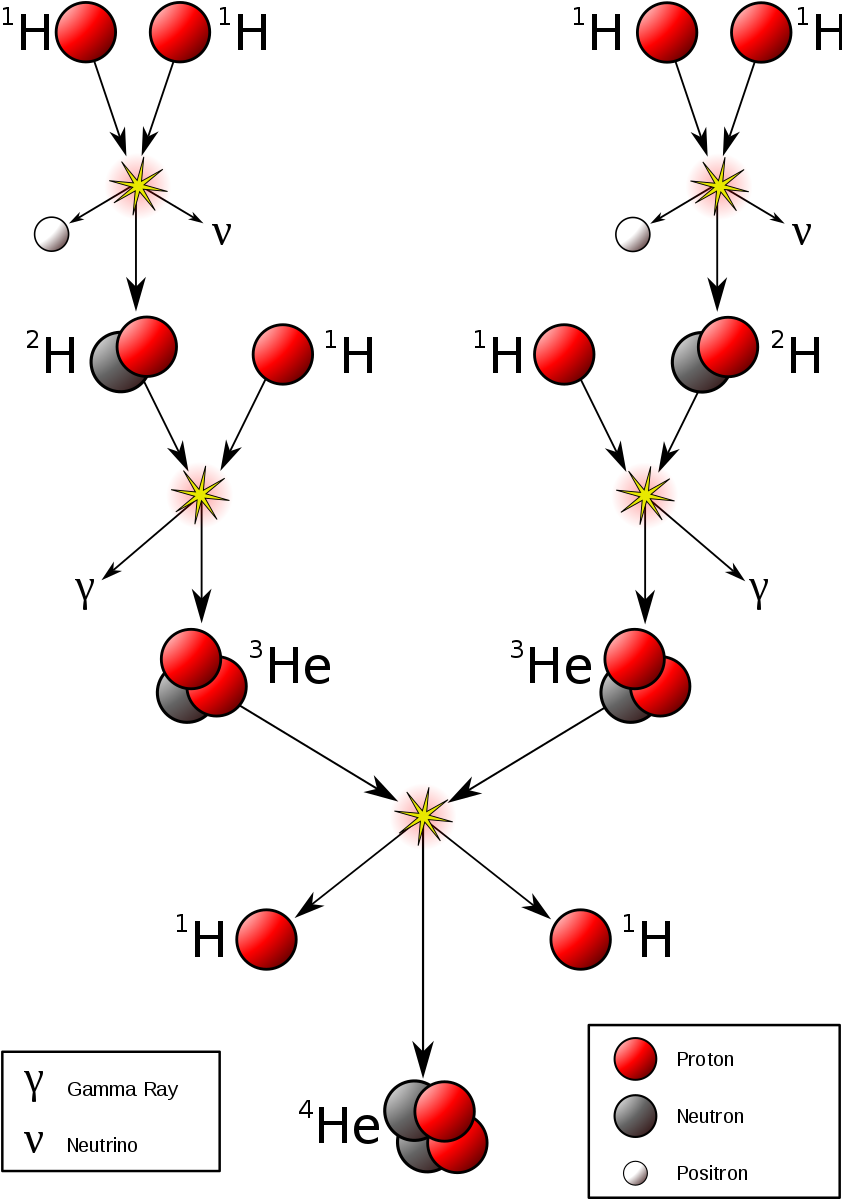 General diagram showing the series of fusion steps that occur in the sun. Two atoms of hydrogen (H) are combined to form a new element helium (He).
General diagram showing the series of fusion steps that occur in the sun. Two atoms of hydrogen (H) are combined to form a new element helium (He).
The giant phase in a star’s life occurs when the star runs out of hydrogen to fuse. Large enough stars have the heat and pressure to now start fusing helium into heavier elements. This style of fusion is more energetic, and the increased energy expands the size of the star with the help of increasing temperatures, ballooning it to a much larger size and brightness. This is predicted to happen to our sun in another few billion years, with the giant phase radius of the sun being at or near the radius of Earth’s orbit, rendering life on Earth impossible. This event will not harm humans if they will learn how to live in other planets.
The mass reached at the main phase is the primary factor determining how the star will evolve. If the star has a large enough mass, it reaches a point at which a new element (such as helium) undergoing fusion is exhausted, and a new element starts the fusion process. This occurs over and over (in stars large enough) forming progressively larger elements like carbon and oxygen. Eventually, this process reaches its limit as iron and nickel are formed. This explains the abundance of iron and nickel in rocky objects (like Earth) within the Solar System. At this point, any further fusion absorbs energy instead of giving it off, starting the beginning of the end for the life of the star.
From stars to galaxies: The Nebular Hypothesis
The origin of a star, of course, is also the origin of a solar system; birth of stars creates galaxies (or nebulas). The nebular hypothesis is the idea that due to the gravity a spinning cloud of dust (called a nebula, with mostly light elements) flattened into a swirling disk, known as the protoplanetary disk (nebula or galaxy), and created a star with orbiting planets in a solar systems.
The vast majority of material collects in the center of the spinning nebula which is why the sun accounts for over 99% of the mass in our solar system.
 Small protoplanetary discs in the Orion Nebula
Small protoplanetary discs in the Orion Nebula
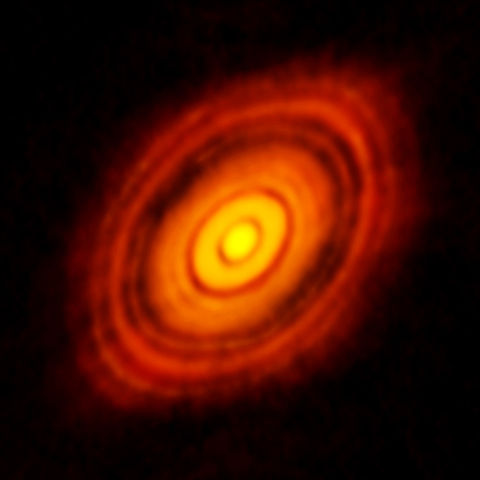 Image by the ALMA telescope of HL Tauri and its protoplanetary disk, showing grooves formed as planets absorb material in the disk.
Image by the ALMA telescope of HL Tauri and its protoplanetary disk, showing grooves formed as planets absorb material in the disk.
Planet Arrangement and Segregation As our solar system formed, it developed distinct zones of temperature within a cloud of dispersed particles. Close to the center, the temperatures were very high, allowing only items with very high temperatures to condense such as metals and silicate minerals. Farther from the sun where temperatures were lower, lighter gaseous molecules such as methane, ammonia, carbon dioxide, and water condensed. Thus, the inner four planets (Mercury, Venus, Earth and Mars) are rocky and the outer four planets (Jupiter, Neptune, Saturn and Uranus) are gaseous (also known as gas giants).
See NASA explanation here: https://solarsystem.nasa.gov/basics/chapter1-2/#:~:text=From%20top%3A%20Mercury%2C%20Venus%2C,surface%20like%20Earth’s%20terra%20firma.
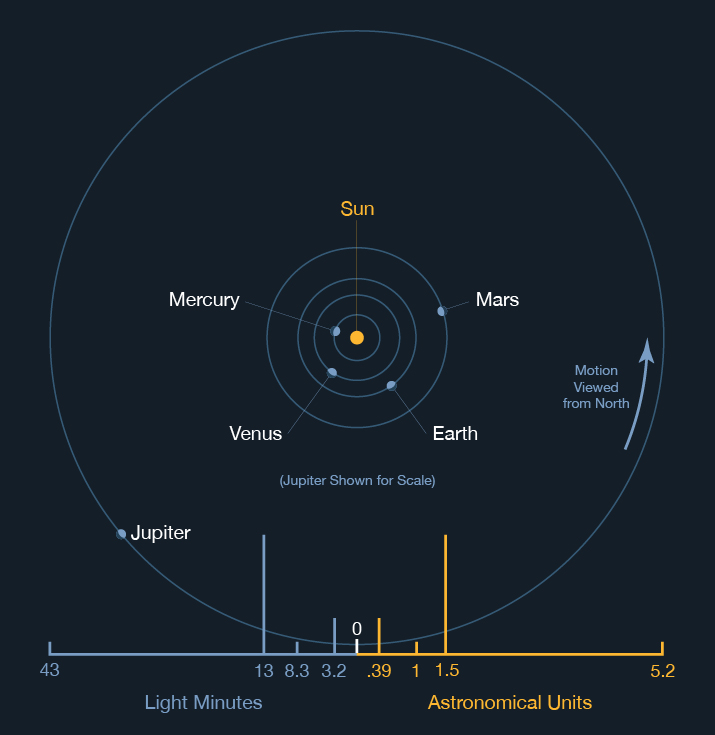
Astronomical Unit (AU): the average distance of Earth from the sun. That’s about 93 million miles, 150 million kilometers or about 8 light-minutes. One light minute = 0.12 AU.
Both rocky and gas styles of planets have a similar model for growth. Particles of dust, floating in the disc, began to be attracted to each other by static charges, and eventually, gravity. Soon, as clumps of dust get bigger and bigger, they began to interact with each other and collide, sticking together, forming even larger planet-starting blocks. Eventually, over the course of many thousands or millions of years, planets were formed as the material in the protoplanetary disc was attracted to the growing planets.
Both rocky and gaseous planets started with a solid core, but rocky planets built on that core with more rock, while gas planets added more gas and ice. Ice giants formed later, got less gas, and therefore, more ice. That is why larger Jupiter and Saturn (gas giants) are mostly hydrogen and helium (>90%), and ice giants Uranus and Neptune are mostly ices of methane, and only about 20% H and He.
It is clear that planetary composition is different, but size is just as dramatically different. The gas giant planets are big for two reasons:
- First, there is more material in a planetary nebula to form gas and ices than metals and rocks (i.e. lots of H, C, O, N, less Si, Fe, etc.) and therefore the outer planets could get larger overall.
- Second, as they got larger, their gravitational pull increased, allowing them to collect large quantities of hydrogen and helium which could not be collected by the smaller inner planets’ smaller gravities
Jupiter’s gravity was able to shape the solar system even more. As material started to coalesce into planets, material close to Jupiter was accelerated, and the collisions here did more destruction than constructive “gluing” together . This is the reason behind the asteroid belt, an “unfinished” planet between Mars and Jupiter. It can also explain Mars’ smaller mass, which Jupiter may have consumed as it migrated into different positions . The asteroid belt is the source of most meteorites that fall to the surface today.
We use meteorites for two primary purposes: to find the age of the Earth and the Earth’s overall composition.
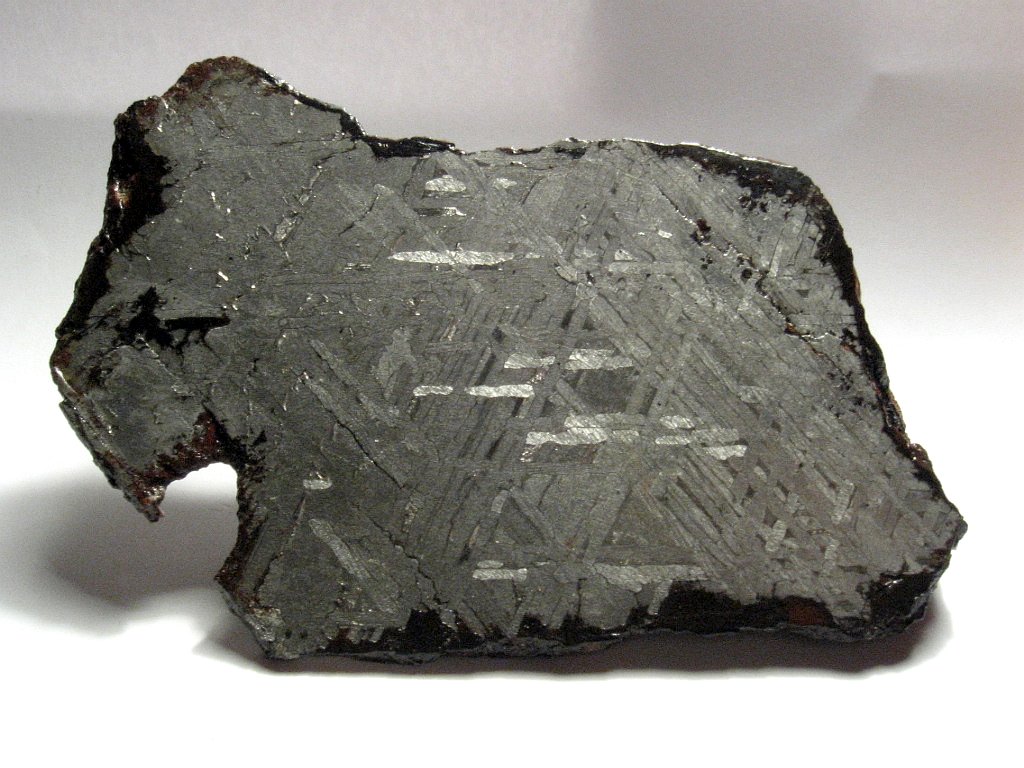 A polished fragment of the iron-rich Toluca Meteorite, with characteristic octahedral Widmanstätten Pattern.
A polished fragment of the iron-rich Toluca Meteorite, with characteristic octahedral Widmanstätten Pattern.
Meteorites became objects of auctions (e.g. Christie’s):
https://onlineonly.christies.com/s/deep-impact-martian-lunar-other-rare-meteorites/lots/2006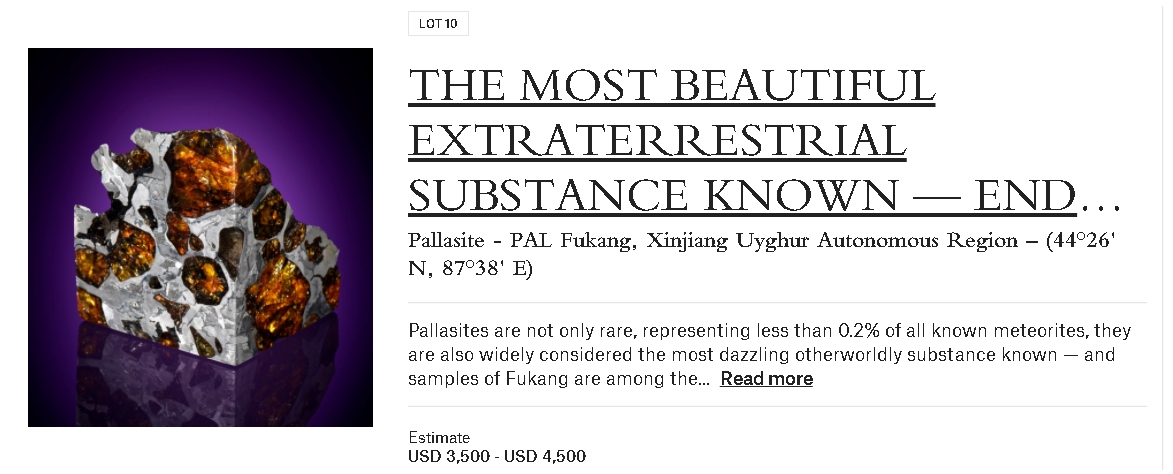
Findings of “fossil” meteorites in ancient rocks:
“It turns out that this can paint a unique picture of how the course of ancient life on Earth was influenced by goings on in space – and has already revealed how space dust from an asteroid collision 466 million years ago could have triggered an ice age. ”
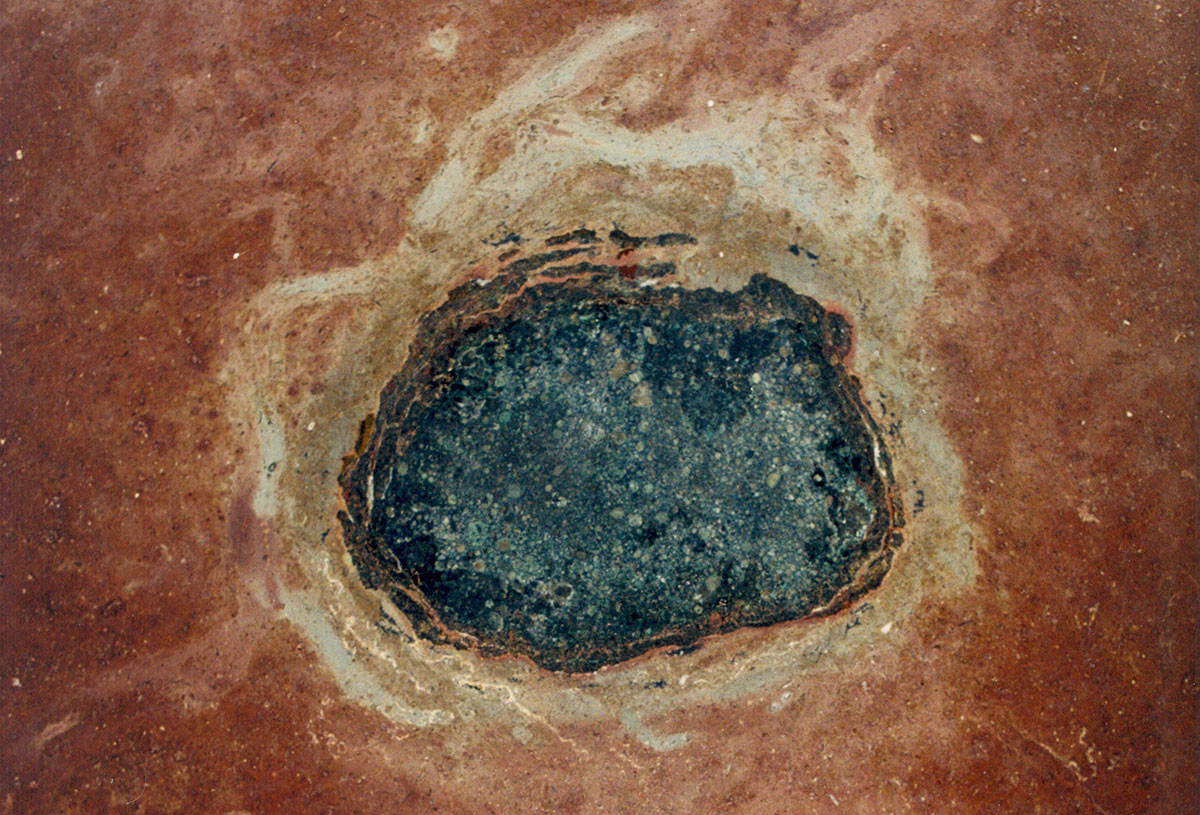
Read full article here: https://phys.org/news/2020-07-space-fossils-window-earth.html
One of the major findings: “The space dust arrival coincides with a cold period known as the mid-Ordovician ice age. Prof. Schmitz concluded that a massive collision in the asteroid belt spewed out both large meteorites and a gargantuan cloud of dust, which blocked lots of sunlight from reaching Earth, leading to an ice age. After the asteroid that killed the dinosaurs, it would be the second example of an event in the wider cosmos profoundly influencing Earth’s story.”
Larger solar objects – comets, made out of ice can provide information on its chemical composition,
Recently (in 2019) scientists made a discovery of the comet from the outer solar system (Borisov comet): https://www.smithsonianmag.com/smart-news/object-flying-through-our-solar-system-likely-interstellar-space-180973114/
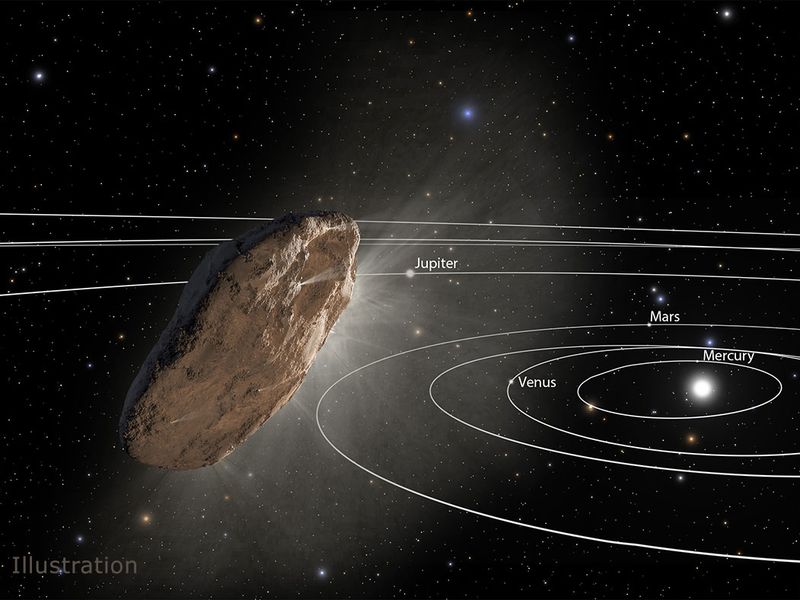

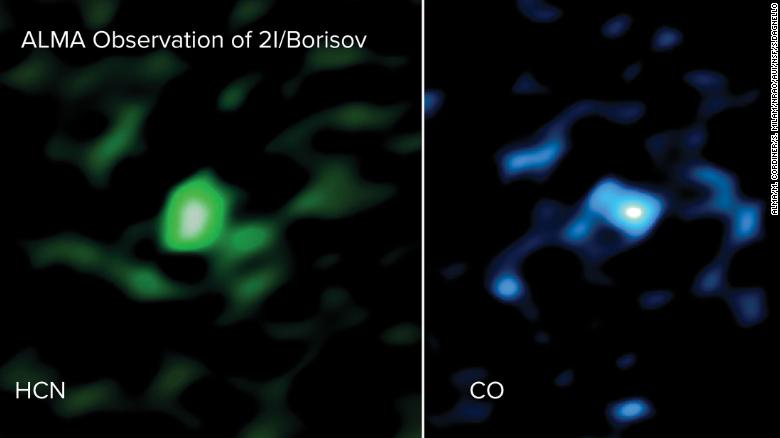
HCN – Hydrogen cyanide; CO – carbon monoxide.
Discovery of the Earth age from meteorites
Meteorites helped to establish Earth age. The first scientist who applied uranijum-lead dating method to meteorites was Clair Cameron Patterson (see: https://en.wikipedia.org/wiki/Clair_Cameron_Patterson). Because Earth materials were extremely modified since its birth they can’t provide direct information on Earth age. Meteorites are considered remnants of the original material from which galaxies were formed. Therefore, their geochemical composition remained almost intact and allowed Clair Cameron Patterson to measure proportions of uranium and lead and estimate the age of the Earth..
Origin of the Crust
As the Earth formed, it was incredibly hot from gravitational compression heating, radioactive decay (which was higher at the start of Earth), and heat from impacts.
As an aside, the majority of this initial heat (dubbed Original Heat) still exists on Earth today. The earliest Earth, chiefly molten material, would have been rounded by the force of gravity, and would have resembled a ball of lava floating in space, with high amounts of volcanism. Slowly, the outer part of the Earth cooled and solid slabs of “protocrust” (a crust precursor) from high melting point minerals formed. They probably were unstable and reabsorbed easily into the liquid magma until further cooling allowed for larger and more numerous fragments to form thin primitive crust. It is generally assumed that this crust would be oceanic and mafic in composition, and littered with impacts, much like the Moon’s current crust.
The exact start of plate tectonics, which presumably would have led to the forming of more felsic (continental) crust, is still under some debate, as is the timing . It is reasonable to think that an early Earth had less dense felsic (light-colored, light, predominantly consisting of silica, Si, and aluminum, Al) materials floating to the surface and denser mafic (dark-colored, heavier, predominantly consisting of magnesium, Mg, and iron, Fe) and ultramafic (similar to mafic, but with less than 45% Si) materials sinking, with iron and nickel sinking to the center from its greater density. This process is called differentiation. It is possible that plate tectonic originated during this period. The earth thus differentiated on the basis of density from a homogenous planet into a heterogenous planet with layers of felsic crust, mafic crust, ultramafic mantle, and iron and nickel core, but the details of the modern origins of crust and tectonics is still mysterious. Starts of convection, separation of the thin crustal slabs by volcanism, and early forms of plate tectonics are still debated.
Origin of the Moon (approx. 4.5 billion years ago)
Earth’s moon has several unique features that have resulted in the current hypothesis for how it formed. First, the Earth and Moon are tidally locked, meaning the moon rotates such that one side of the Moon always faces the Earth, and the other side is “dark” (to us) because Earth cannot see it. More on this phenomenon: https://www.youtube.com/watch?v=j91XTV_p9pc
Also, and most importantly, the chemical composition of the Earth and the Moon were able to be compared after the Apollo missions returned moon rocks. Very precise analysis of details in Moon rocks and Earth rocks show isotope ratios and volatile content are nearly identical from each body.
Other bodies in the solar system and meteorites do not share the same amount of similarity and have a much higher variability. If the Moon and Earth formed together, then it is easy to explain why they are so similar chemically. The hypothesis of the origin of the Moon is based on possible impact from collision of Earth with a huge (possibly Mars-size) asteroid.

Dark side of the moon
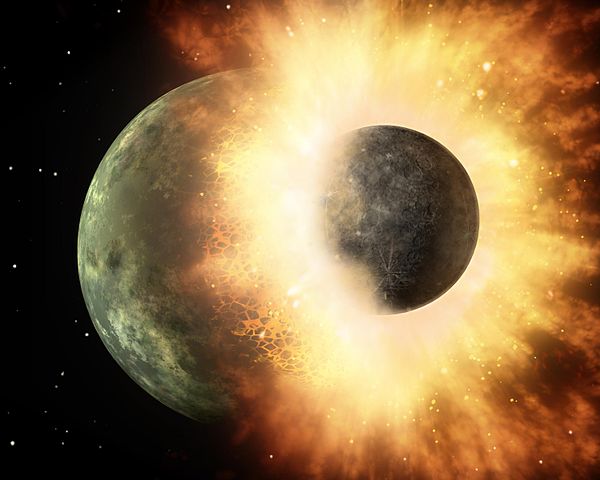 Artist’s concept of the giant impact from a Mars-sized object that could have formed the moon.
Artist’s concept of the giant impact from a Mars-sized object that could have formed the moon.
Below is a poet’s imagination about this event:
The Great Wound by Robinson Jeffers (from The Beginning and The End)
Agitated the molten surface of the earth.
The tides grew higher as it passed. It tore from the earth
The top of one great wave: the moon was torn
Out of the Pacific basin: the cold white stone that lights
us at night
Left that great wound in the earth, the Pacific Ocean
With all its islands and navies. I can stand on the cliff
here
And hear the half-molten basalt and granite tearing apart
and see that huge bird
Leaping up to her star. But the star passed,
The moon remained, circling her ancient home,
Dragging the sea-tides after her, haggard with loneliness.
The mathematicians and physics men
Have their mythology; they work alongside the truth,
Never touching it; their equations are false
But the things work. Or, when gross error appears,
They invent new ones; they drop the theory of waves
In universal ether and imagine curved space.
Nevertheless their equations bombed Hiroshima.
The terrible things worked.
The poet also
Has his mythology. He tells you the moon arose
Out of the Pacific basin. He tells you that Troy was
burnt for a vagrant
Beautiful woman, whose faced launched a thousand ships.
It is unlikely: it might be true: but church and state
Depend on more peculiarly impossible myths:
That all men are born free and equal: consider that!
And that a wandering Hebrew poet named Jesus
Is the God of the universe. Consider that!
Earth’s Water
Many different ideas for the origin of Earth’s water have been proposed. One hypothesis is that water originated from inside the Earth itself, via tectonic processes and volcanic outgassing . Since all volcanic eruptions contain some water vapor, at times more than 1% of the volume, this alone could be an explanation of Earth’s water. The other likely source of water is from space. Comets are a mixture of dust and ice, with some or most of that ice being water. Meteors, while seemingly dry, can contain a small but measurable amount of water, usually trapped in mineral structures . During heavy bombardment (see below), the Earth’s cooled surface would have been pummeled by both comets and meteorites, and this could be why so much water is found on the surface. So which source matches ocean water? The answer is not definitive. Isotopically, water on Earth matches water in meteorites much better than comets . However, it is hard to know if processes on Earth could have changed the isotopic signature of water over the last 4+ billion years . Most likely, all three sources contributed to Earth’s water in the past, and continue to add trace quantities of water today.
Water vapor leaves comet 67P/Churyumov–Gerasimenko
Water is the most unusual matter. See BBC documentary: https://www.bbc.com/reel/video/p06y2c9k/why-water-is-one-of-the-weirdest-things-in-the-universe?ocid=ww.social.link.email
Late Heavy Bombardment
At the start of the solar system, objects were chaotically flying around, building up the planets and moons. Well after the planets were made, about 4.1 to 3.8 billion years ago, there is evidence of a second, later large spike of impacts from asteroids and comets on Earth and the Moon in an event called the Late Heavy Bombardment .
At this time, meteorites and comets, which were presumably in stable or semi-stable orbits, began to become unstable and started impacting objects throughout the solar system. This idea is also known as the lunar cataclysm, though this leads to the biggest criticism of the theory: limited lunar sampling. During the Late Heavy Bombardment, Earth, the Moon, and all the planets were pummeled by a large amount of material from the Asteroid and Kuiper Belts, and evidence of this was found within lunar samples returned from the Moon.
These panels show the relative scale of (clockwise from top left): the inner solar system and the outer solar system. The main part of the Kuiper Belt begins at Neptune’s orbit. Credit: NASA/Caltech
While it is universally accepted that bombardment from asteroids and comets would have been extensive at the start of the solar system, some other process must have caused an increase in impacts hundreds of millions of years later. A leading theory blames gravitational resonance between Jupiter and Saturn which disturbed orbits within the asteroid belt and the Kuiper belt . This process has even been hypothesized from observations of the star system Eta Corvi.
Origin of the Continents
In order to have plate tectonics (as the process works today), it is necessary to have continents. Somehow, with a timing and process that is still debated, volcanic action must have brought the first continental material to the surface during the Hadean, 4.4 billion years ago . This does not solve the problem of forming continents, since magmatic differentiation seems to need thicker crust. Nevertheless, it happened somehow by some incremental process .
The best idea is that density differences in the materials of the early earth allowed lighter felsic materials to float upwards and heavier ultramafic materials and metallic iron to sink. These density differences led to the layering of the earth that is now detected by seismic studies. Early proto-continents added additional felsic material as plate tectonic processes developed and brought more material from the mantle to near the surface .
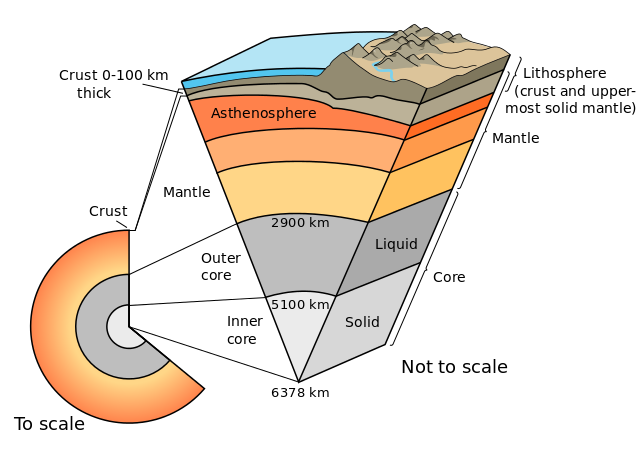 The layers of the Earth. Physical layers include lithosphere and asthenosphere; chemical layers are crust, mantle, and core.
The layers of the Earth. Physical layers include lithosphere and asthenosphere; chemical layers are crust, mantle, and core.
The first solid evidence of modern plate tectonics is not found until the end of the Archean (4,000 to 2,500 million years ago), meaning the beginnings of continental lithosphere must have been in place by then. This does not necessarily mean that the starting point of plate tectonics occurred then; it could mean that earlier evidence was erased in the rock cycle. Regardless, there still has to be an explanation of going from little to no continental material in the Hadean (4,600 to 4,000 million years ago), and up to 70% of the volume of the modern continents by the end of the Archean .
Overall, Archean rocks are still very rare, and they make up only a small portion of the continental rocks that exist on the surface today. Once present and persistent at the earth’s surface, continents are subject to tectonic activity (now related to plate tectonics), burial by sediments, and erosion. Tectonic processes probably destroyed the earliest continental rocks that formed, and only a few rocks survived. Tectonics could also explain the origin of lighter materials through magmatic differentiation. Or, perhaps plate tectonics had not fully started because oceanic crust was too hot and buoyant to subduct, and something similar to a hot spot with rising material from within the Earth could form continents .
These early continental masses would lead to a craton, the strong, seemingly stable nucleus of each continental mass or fragment (see figure below), consisting of two main parts: the shields which are crystalline basement near the surface, and platforms, which have sedimentary rocks covering the shield.
Cratons are mostly Archeanian age, and have remained relatively unchanged since then, with most (if not all) tectonic activity occurring around them, instead of within them. Whether plate tectonics or another process started the continents, Archean continents initiated the origin of the Proterozoic continents that now dominate our planet.
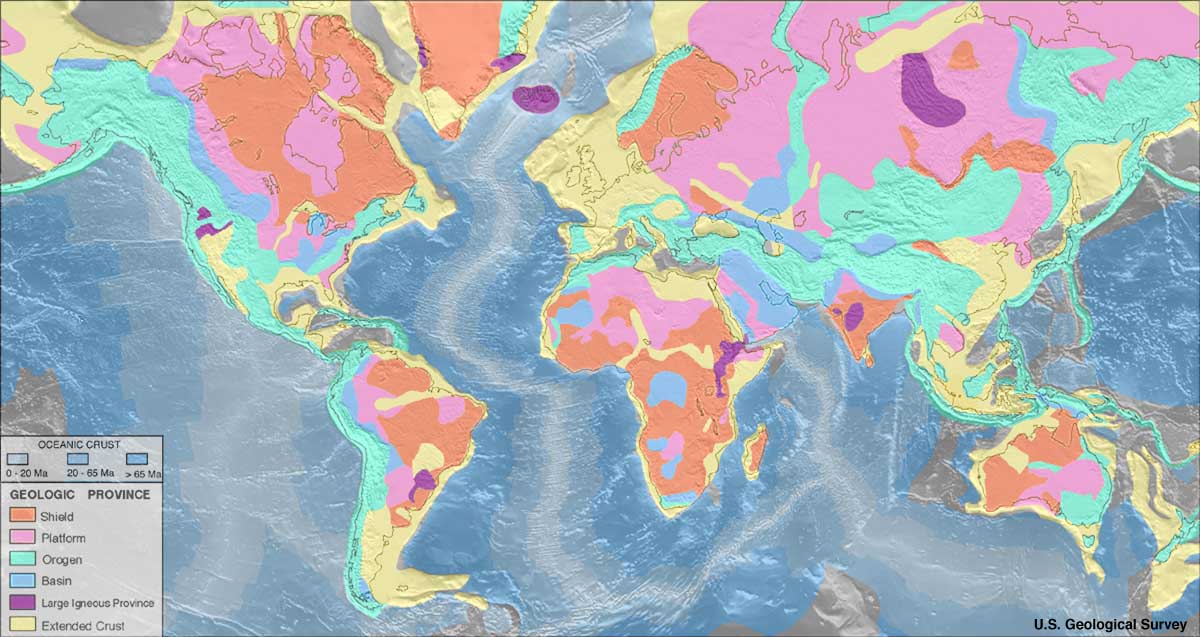
Geologic provinces of Earth. Cratons are pink and orange (shield + platform).
The general guideline as to what constitutes a continent, a subcontinent, and differentiates oceanic from continental crust is under some debate.
Continents and subcontinents are generally cored by one or more cratons, as well as contain felsic igneous rocks. There is evidence of submerged masses like Zealandia, that includes New Zealand, that could be considered continents. A piece of continental crust that does not contain a full craton structure, like Madagascar, would be called a continental fragment .
First Life on Earth
Life mostly likely started early in the Archean eon or the end of the Hadean eon. The earliest evidence, even if not as robust as obvious fossils, is carbon derived from life found within zircon grains from 4.1 billion years ago. The oldest well-preserved fossils are 3.77 to 4.28 billion year old filaments from a hydrothermal vent deposit in Quebec or 3.5 billion year old photosynthetic microbial mats (stromatolites) from Australia. Therefore, although evidence for life older than 3.5 billion years ago is not as strong, there is significant evidence for life starting at least around 3.5 billion years ago. The mechanism for which life started is unknown, though many ideas have been proposed.
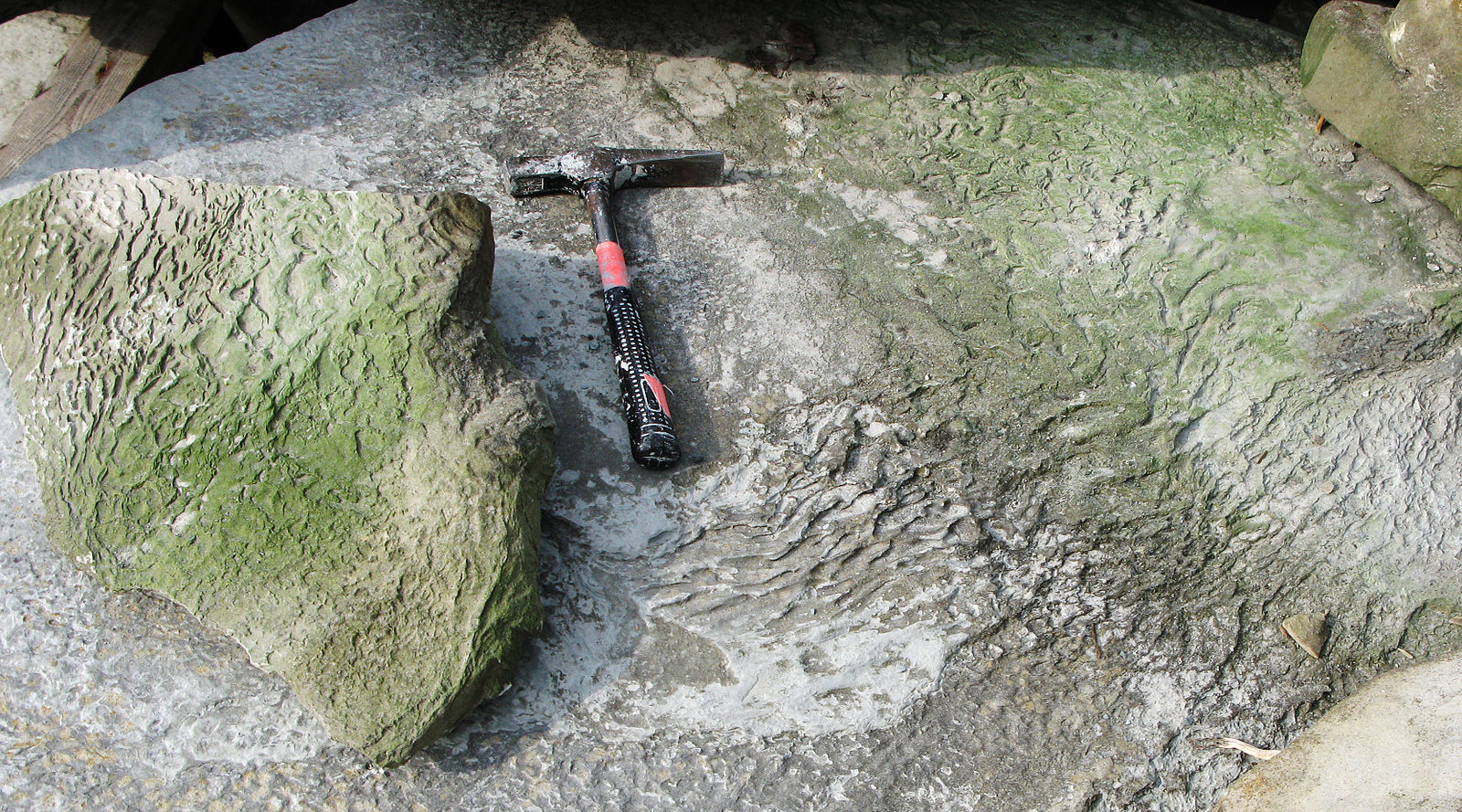
Fossils of microbial mats from Sweden
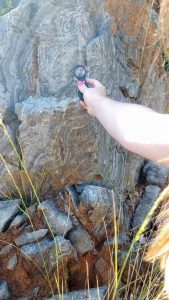
Stromatolite from Crete (Greece).
One of the ideas is that life could have arisen from the chemical environment of the atmosphere and oceans that was very different than today. The atmosphere was reducing (had no free oxygen) with abundant methane, carbon dioxide, and other sulfur and nitrogen compounds like other bodies in the solar system.
The famous Miller-Urey experiment simulated this early Earth’s atmosphere in a vessel and ignited sparks within it to simulate lightning. Amino acids were found to form in the vessel . Amino acids are the fundamental building blocks of proteins.
There are many other possibilities that could have led to life on Earth, including findings in hydrothermal vents like the black smokers on mid-ocean ridges today. In 1977, when scientists discovered an isolated ecosystem around such vents on a mid-ocean ridge , it opened the door to consider other ways for life to exist and have started, and eventually expanded the search for life to more unconventional places, like Jupiter’s icy moon Europa . The oldest possible fossils, which could be as old as 4.28 billion years old, add credence to this idea .
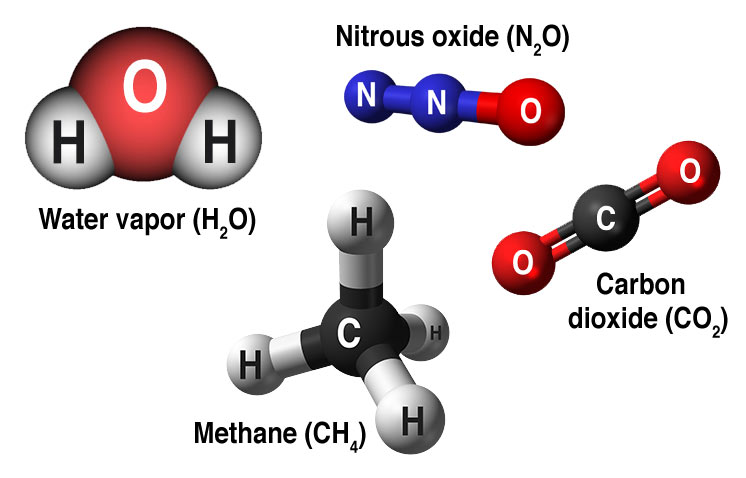
Greenhouse gases were more common in Earth’s early atmosphere
Animation of the original Miller-Urey 1959 experiment that simulated the early atmosphere and created amino acids from simple inorganic elements and compounds.
Another possibility for the origin of life on earth is from comets or other objects from space. Some of the chemical components of life (e.g. amino acids) have been shown to exist within comets and meteorites . All of these are intriguing since they imply a high likelihood of life existing elsewhere in the cosmos.
THE HISTORY OF EARTH documentary film
(we can watch first 32 min):
Simplified, “kid’s friendly” version of 4.5 Billion Years in 1 Hour:
https://youtube.com/watch?v=S7TUe5w6RHo%3Fsi%3D6nUGnigC0ULvRCif
